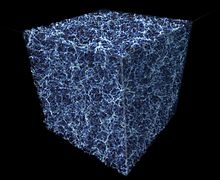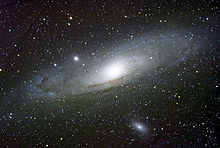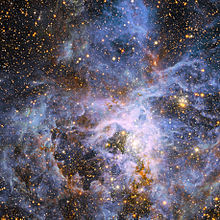Universe
![]()
The title of this article is ambiguous. For other meanings, see Universe (disambiguation).
![]()
Universe is a redirect to this article. The term space is also used with the meaning of outer space.
The universe (from Latin universus 'total'), also called the cosmos or the universe, is the totality of space, time and all matter and energy in it. The observable universe, on the other hand, is limited to the found arrangement of all matter and energy, starting with elementary particles and ending with large-scale structures such as galaxies and clusters of galaxies.
Cosmology, a branch of both physics and contemporary philosophy of science, is concerned with the study of the universe and attempts to answer properties of the universe such as the question of the fine-tuning of natural constants.
The theory generally accepted today to describe the large-scale structure of the universe is the standard model of cosmology. It is based on general relativity in combination with astronomical observations. Quantum physics has also made important contributions to understanding specifically the early universe of the period just after the Big Bang, when density and temperature were very high. It is likely that an expanded understanding of the universe will not be achieved until physics devises a theory that unites general relativity with quantum physics. This theory of quantum gravity, called the "Theory Of Everything" or the world formula, is supposed to explain the four basic forces of physics in a unified way.

Structure of the universe
Origin of the designations
The word "universe" was Germanized in the 17th century by Philipp von Zesen by the word "Weltall". While the universe or outer space encompasses everything, the term outer space refers only to the space outside the Earth's atmosphere and outside the atmospheres of other celestial bodies, in which there is almost a vacuum. Colloquially, however, "universe" or "space" is also used with the meaning of "outer space".
The term "cosmos" is borrowed from the ancient Greek κόσμος 'order' and expresses, in addition to the term "universe", that the universe is in an "orderly" state, as a counter term to chaos. It is attested since the 19th century and is the word root for cosmonaut, the designation for Soviet or Russian astronauts.
Age and composition
The classical and today widely accepted big bang theory assumes that the universe emerged from a singularity at a certain moment, the big bang, and has been expanding ever since (see expansion of the universe). According to this theory, time, space and matter came into being with the big bang. Times "before" the big bang and places "outside" the universe are physically not definable. Therefore, in physics there is neither a spatial "outside" nor a temporal "before" nor a cause of the universe.
Since the scientific laws for the extreme conditions during the first approximately 10-43 seconds (Planck time) after the Big Bang are not known, the theory does not describe the actual process strictly speaking. Only after the Planck time has elapsed can the further processes be physically reconstructed. For example, a temperature of 1.4 - 1032 K (Planck temperature) can be assigned to the early universe.
The age of the universe is measured very precisely due to precision measurements by the Planck space telescope: 13.81 ± 0.04 billion years. An earlier determination of the age by the WMAP satellite gave the somewhat less accurate result of 13.7 billion years. The age can also be calculated by extrapolating from the instantaneous expansion rate of the universe to the time when the universe was compressed to a point. However, this calculation depends strongly on the composition of the universe, since matter or energy slows down the expansion due to gravitation. However, dark energy, which has so far only been indirectly detected, can also accelerate the expansion. Thus, different assumptions about the composition of the universe can lead to different ages. The age of the oldest stars can be used to give a lower limit for the age of the universe. In the current Standard Model, the results of these methods agree very well.
All calculations for the age of the universe presuppose that the Big Bang can actually be regarded as the temporal beginning of the universe, which is not certain due to ignorance of the laws of physics for the state immediately after the beginning of the Big Bang. While a static universe that is infinitely old and infinitely large can be ruled out, a dynamic infinitely large universe cannot. This is justified among other things by the observed expansion of the universe. Furthermore, the astronomer Heinrich Wilhelm Olbers already pointed out that with infinite expansion and infinite age of a static universe, the night sky would have to shine brightly (Olbers' paradox), since every gaze that one directs into the sky would automatically have to fall on a star. However, if the universe is infinitely large but has only a finite age, the light from certain stars has simply not reached us yet.
The space between galaxies is not completely empty, but contains stars and dust clouds as well as hydrogen gas, among other things. This intergalactic medium has a density of about one atom per cubic meter. Within galaxies however, density of materia is much higher. Similarly, space is riddled with fields and radiation. The temperature of the background radiation is 2.7 Kelvin (i.e. about -270 °C). It arose 380,000 years after the Big Bang. The universe consists only to a small part of matter and energy known to us (5%), of which again only 10% emits light and is therefore visible. Dark matter makes up a larger part (27%). Dark matter has been indirectly detected by a large number of observations, but its composition is still largely not understood. The largest part is dark energy (68%), which is responsible for the accelerated expansion. Dark energy has been inferred from data from distant supernova explosions, and its existence is confirmed by satellites such as COBE, WMAP, and Planck, balloon experiments such as BOOMERanG, and gravitational lensing effects and the galaxy distribution in the universe.

The Andromeda galaxy, the closest major galaxy to us...

The Tarantula Nebula
Questions and Answers
Q: What is the Universe?
A: The Universe is all of time and space and its contents, including many millions of billions of stars, planets, and enormous clouds of gas.
Q: How do astronomers observe distant galaxies?
A: Astronomers use telescopes to look at very distant galaxies. This allows them to see what the Universe looked like a long time ago since light from distant parts of the Universe takes a long time to reach us.
Q: Have physical laws and constants in the Universe changed over time?
A: From observations, it seems that physical laws and constants in the Universe have not changed.
Q: Do physicists know if anything existed before the Big Bang?
A: Physicists are currently unsure if anything existed before the Big Bang.
Q: Is the size of the Universe infinite?
A: Physicists are also unsure whether or not the size of the universe is infinite, meaning its size never ends as it has been expanding since the Big Bang.
Search within the encyclopedia